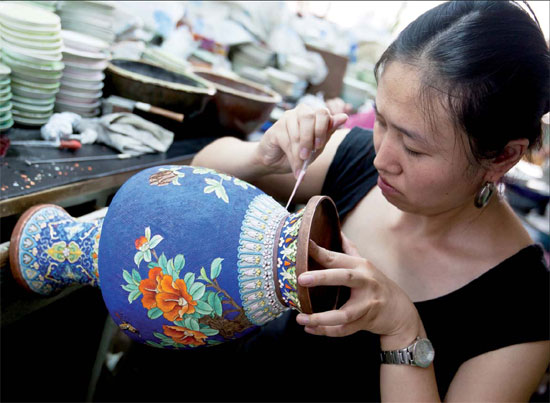Born of Beijing
Updated: 2013-01-04 07:45
By Yin Yin (China Daily)
|
||||||||
|
A craftswoman working on a Cloisonn vase in Beijing, where the art form was created. Zhao Bing / For China Daily |
Developed from skills brought to China on Kublai Khan's western expedition, the intricate craftwork of Cloisonne is an art now typical of the country's capital
Tourist Patricia Beus picks out an exquisite decoration of white porcelain inlaid with a multitude of colors from among the shops at Beijing Panjiayuan Antiques Market. "This kind of artwork is very rare and very hard to find in my hometown," she says. "The shopkeeper tells me it's called Jingtailan in Chinese."
Jingtailan, or Cloisonn as it's also known, is a craft born and developed in Beijing. It involves a unique combination of sculpture, painting, porcelain and copper-smithing.
There is no unified answer about the origins of Cloisonn, but it is commonly believed to have spread into China on Kublai Khan's western expedition during the Yuan Dynasty (1271-1368). After learning the skill of manufacturing enamel products, Chinese craftsmen then improved the technique over time to develop the distinctive artform.
Cloisonn was given its present Chinese name during the reign of Emperor Jingtai in the Ming Dynasty (1368-1644). During this period some of the most exquisite Cloisonn was produced.
The craft reached its peak in the Qing Dynasty (1644-1911) due to innovations in copper-smelting techniques.
According to Zhang Lifu, a professional craftsman who has been making Cloisonn for 40 years, "Jingtailan means blue of Jingtai in Chinese because craftsmen found a blue glaze in dark blue which is clear and elegant. Jingtailan work was usually fused with the special blue enamel as a base color".
During the Ming and Qing dynasties, Cloisonn products were primarily used in the imperial household. Historical records show that at the New Year's Eve banquet of Qing Emperor Qianlong, only the emperor's dinnerware was made of Cloisonn. This suggests that Cloisonn was a symbol of high status at that time.
In the late Qing Dynasty it emerged as a mass-produced product and during the reign of Emperor Daoguang (1821-1850) exports began.
In later years Cloisonn's popularity grew overseas, says Chen Jianguo, a scholar at the Chinese Folk Literature and Art Society.
"Jingtailan Precious Tripods Furnace won first prize at the St. Louis World Expo in 1904. And in 1915 a Cloisonn piece won again at the Panama Pacific International Exposition. These events gave Cloisonn worldwide recognition," he says.
Making Cloisonn is an elaborate process that first involves soldering brass wires to the surface of a copper object to form a pattern or picture.
Zhang says, "Craftsmen need to design creatures and each metal piece is delicately bent with pliers."
The designs are usually floral or include birds, dragons and fish. Their intention is to depict the peace and harmony of nature.
They are glued or welded on to the Cloisonn product, which is then placed in a kiln at a temperature of about 900 C.
"This step of filigree soldering is very important," Zhang says. "It requires great care and creativity. Sometimes, the patterns are complicated and the craftsman must use his imagination to complete them."
The next stage is enamel filling. For this, the craftsman uses boric acid, red lead, alkaline, glass powder and saltpeter to create different colors.
"After ores are ground into fine powder and placed onto plates, the artisan applies them to the small compartments separated by filigrees," Zhang says.
"The copper body of the article will turn red in the crucible for a moment under repeated firing, and then the enamel in the small compartments will become smooth and glossy."
Then the craftsman uses charcoal and whetstone to polish the surface into a fine luster, before finally dipping it into liquid gold or silver to alter its electric current so that it won't rust.
Examples of antique Cloisonn can be found at many of China's most visited tourist attractions, including the Forbidden City and the Summer Palace.
Cloisonn objects, including vases, utensils, chopsticks, cups and jars, can also be purchased across the country.
While it is an ancient skill, it is not dying. Cloisonn products remain popular and craftsmen are passing on their skills to a new generation who will continue to keep the artform alive and perhaps develop it further.
yinyin@chinadaily.com.cn
(China Daily 01/04/2013 page18)

 Li Na on Time cover, makes influential 100 list
Li Na on Time cover, makes influential 100 list
 FBI releases photos of 2 Boston bombings suspects
FBI releases photos of 2 Boston bombings suspects
 World's wackiest hairstyles
World's wackiest hairstyles
 Sandstorms strike Northwest China
Sandstorms strike Northwest China
 Never-seen photos of Madonna on display
Never-seen photos of Madonna on display
 H7N9 outbreak linked to waterfowl migration
H7N9 outbreak linked to waterfowl migration
 Dozens feared dead in Texas plant blast
Dozens feared dead in Texas plant blast
 Venezuelan court rules out manual votes counting
Venezuelan court rules out manual votes counting
Most Viewed
Editor's Picks

|

|

|

|

|

|
Today's Top News
Boston bombing suspect reported cornered on boat
7.0-magnitude quake hits Sichuan
Cross-talk artist helps to spread the word
'Green' awareness levels drop in Beijing
Palace Museum spruces up
First couple on Time's list of most influential
H7N9 flu transmission studied
Trading channels 'need to broaden'
US Weekly

|

|








